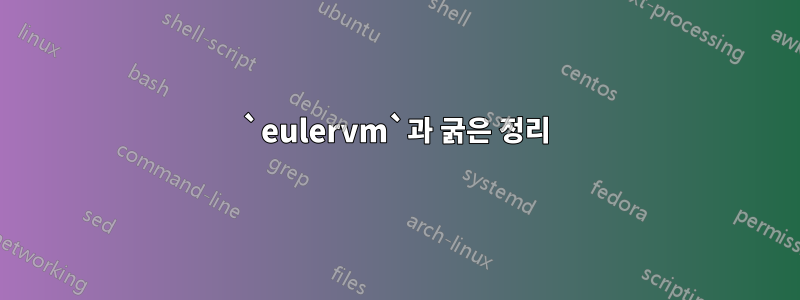
나는 concrete-romanKnuth의 것과 같이 사용합니다.구체적인 수학내 주요 글꼴로. 하지만 수학 글꼴이 제공되지 않으므로 포함합니다 eulervm.
\usepackage{amsmath,amssymb,amsthm}
\usepackage{concrete}% the concrete-roman, used in concrete mathetics
\usepackage{eulervm}% the math fonts used in concrete mathematics
내가 정리를 대담하게 시도하기 전까지는 이것은 잘 진행되었습니다. 즉, 대신
정리 4.1. 1+1 = 2
나는 원해요
정리 4.1.1+1 = 2.
이를 위해 헤더 복사에 다음 명령을 추가했습니다. amsthm으로 정리의 선택적 제목을 굵게 표시하는 방법은 무엇입니까?
\newtheoremstyle{mystyle}% % Name
{}% % Space above
{}% % Space below
{}% % Body font
{}% % Indent amount
{\bfseries}% % Theorem head font
{.}% % Punctuation after theorem head
{.5em}% % Space after theorem head, ' ', or \newline
{\thmname{#1}\thmnumber{ #2}\thmnote{ (#3)}}% % Theorem head spec (can be left empty, meaning `normal')
\theoremstyle{mystyle}
\numberwithin{equation}{subsection}
\newtheorem{theorem}[equation]{Theorem}
작동하지 않습니다.
을 제거하면 eulervm정리가 굵게 표시됩니다. 그러나 글꼴은 일부 기본 글꼴로 대체됩니다.
질문
굵게 표시된 정리를 사용하여 글꼴 의 라라랜드에 머무르는 방법은 무엇입니까 concrete+eulervm?
관련이 있을 수도 있음
에서 지적한 바 있다Eulervm의 대담한 수학굵은 글꼴을 다르게 처리 합니다 eulervm. 하지만 굵은 수학 글꼴만 다루었습니다.
최소한의 예
다음은 $ pdflatex. eulervm내 질문에 설명된 효과를 보려면 전환할 수 있습니다 . mystyle실제로 작동하고 있음 을 확인하세요 . 비활성화하면 \theoremstyle{mystyle}본문 글꼴이 기울임꼴(기본값)로 변경됩니다.
\documentclass[15pt]{article}
\usepackage[margin=1in]{geometry}
\usepackage[utf8]{inputenc}
\usepackage{amsmath,amssymb,amsthm}
\usepackage{concrete}% the concrete-roman, used in concrete mathetics
\usepackage{eulervm}% the math fonts used in concrete mathematics
\newtheoremstyle{mystyle}% % Name
{}% % Space above
{}% % Space below
{}% % Body font
{}% % Indent amount
{\bfseries}% % Theorem head font
{.}% % Punctuation after theorem head
{.5em}% % Space after theorem head, ' ', or \newline
{\thmname{#1}\thmnumber{ #2}\thmnote{ (#3)}}% % Theorem head spec (can be left empty, meaning `normal')
\theoremstyle{mystyle}
\newtheorem{theorem}[equation]{Theorem}
\begin{document}
\begin{theorem}
The sum of $1$ and $1$ is $2$.
\end{theorem}
\end{document}
답변1
글꼴 설명 파일을 조금 조사한 후 굵은 글꼴 대체가 작동하지 않는 이유를 발견했습니다. 콘크리트는 굵게 표시되지 않으며 글꼴 패키지는 인코딩 /bx/n의 시리즈 및 모양 에 대한 대체만 선언합니다 T1. 기본적으로 /b/n를 사용하려고 했습니다 OT1.
따라서 명령을 바꿀 수 있습니다
\usepackage{concrete}
~와 함께
\usepackage[T1]{fontenc}
\usepackage{ccfonts}
\renewcommand\bfdefault{bx}
unicode-math하지만 가능하다면 LuaLaTeX를 사용하고, 필요할 경우 레거시 8비트 글꼴을 사용하는 것이 좋습니다 . 보다이 답변몇 가지 더 긴 예를 들어 보겠습니다.
자신만의 정리 스타일을 정의하는 것이므로 헤더에 대해 원하는 글꼴을 선택할 수 있습니다(예: Latin Modern Sans-Serif Semi-bold Condensed).
\documentclass[15pt]{article}
\usepackage[margin=1in]{geometry}
\usepackage[T1]{fontenc}
\usepackage[utf8]{inputenc} % The default since 2018
\usepackage{amsmath,amssymb,amsthm}
\usepackage{bm}
\usepackage{ccfonts}% the concrete-roman, used in concrete mathetics
\usepackage{eulervm,eucal,eufrak}% the math fonts used in concrete mathematics
\renewcommand\bfdefault{bx}
\newtheoremstyle{mystyle}% % Name
{}% % Space above
{}% % Space below
{}% % Body font
{}% % Indent amount
{\usefont{T1}{lmss}{sbc}{n}}% % Theorem head font
{.}% % Punctuation after theorem head
{.5em}% % Space after theorem head, ' ', or \newline
{\thmname{#1}\thmnumber{ #2}\thmnote{ (#3)}}% % Theorem head spec (can be left empty, meaning `normal')
\theoremstyle{mystyle}
\newtheorem{theorem}[equation]{Theorem}
\begin{document}
\begin{theorem}
The sum of $1$ and $1$ is $2$.
\end{theorem}
\end{document}


